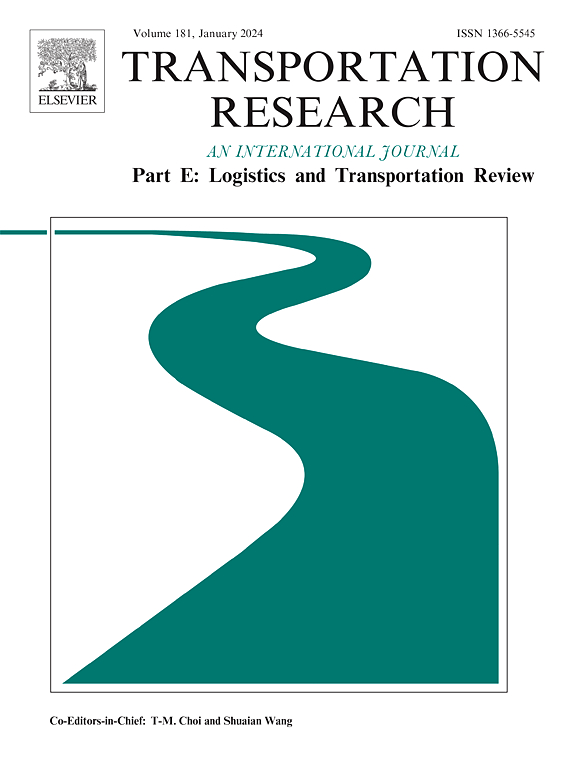增强城市轨道交通弹性:战略性公交资源配置
IF 8.8
1区 工程技术
Q1 ECONOMICS
Transportation Research Part E-Logistics and Transportation Review
Pub Date : 2025-07-22
DOI:10.1016/j.tre.2025.104327
引用次数: 0
摘要
城市轨道交通(URT)系统是城市交通不可或缺的一部分,但容易受到干扰,这可能会严重影响服务的连续性和乘客的便利性。越来越多的轨道交通中断事件需要有效的战略来确保稳健和有弹性的交通运营。临时征用常规公交作为桥接服务已成为缓解轨道交通服务中断不利影响的常用策略。本文研究了一种新的宏观层面的常规公交整合规划问题,旨在优化常规公交资源配置(包括车辆段位置、车队和车线分配)和公交桥接服务,以应对轨道交通中断(包括常规公交车辆段、征购公交车和轨道交通站点之间的映射关系),以最大限度地减少运营中断,提高服务可靠性。提出了一种双目标整数规划模型,将常规公交服务规划与公交桥接服务相结合,以应对轨道交通中断,最大限度地减少总滞车时间,减少无人服务的乘客数量。提出了一种结合字典优化和乌托邦点的增强型ε约束方法来生成平衡Pareto最优解。该模型通过案例研究进行了测试,包括小规模(南昌地铁网络的一部分)和大规模(整个南昌地铁网络,南京地铁网络和成都地铁网络)的中断,基于现实世界的数据。结果表明,我们的方法可以产生高质量的解决方案,显著提高运营效率和公交服务对轨道交通中断的响应能力。这些策略可确保定期巴士服务运作顺畅,减轻轨道交通中断的影响,并促进巴士资源的成本效益利用。本文章由计算机程序翻译,如有差异,请以英文原文为准。
Enhancing urban rail transit resilience: Strategic bus resource allocation
Urban rail transit (URT) systems are integral to urban mobility but are susceptible to disruptions that can substantially impact service continuity and passenger convenience. The increasing incidents of URT disruptions necessitate effective strategies to ensure robust and resilient transit operations. Temporarily requisition regular buses to serve as bridging services has become a common strategy to mitigate the adverse effects of URT service disruptions. This study investigates a novel macro-level integration planning problem of regular buses, aiming to optimize both regular bus resource allocation (including depot location, vehicle fleet and vehicle-to-line assignment) and bus bridging services in response to URT disruptions (including the mapping relationships between regular bus depots, requisitioning buses and URT stations), with the goal of minimize operational disruptions and enhance service reliability. A bi-objective integer programming model is developed to integrate regular bus service planning with bus bridging services in response to URT disruptions, minimizing the total deadheading time and reducing the number of unserved passengers. An augmented ε-constraint method, combined with lexicographic optimization and a utopian point, is proposed to generate balanced Pareto optimal solutions. The model is tested through case studies involving both small-scale (part of the Nanchang Metro network) and large-scale (entire Nanchang Metro network, Nanjing Metro network and Chengdu Metro network) disruptions, based on real-world data. Results demonstrate that our approach can produce high-quality solutions that significantly enhance the operational efficiency and responsiveness of bus services to URT disruptions. These strategies ensure smooth operation of regular bus services, mitigate the impacts of URT disruptions, and promote cost-effective utilization of bus resources.
求助全文
通过发布文献求助,成功后即可免费获取论文全文。
去求助
来源期刊
CiteScore
16.20
自引率
16.00%
发文量
285
审稿时长
62 days
期刊介绍:
Transportation Research Part E: Logistics and Transportation Review is a reputable journal that publishes high-quality articles covering a wide range of topics in the field of logistics and transportation research. The journal welcomes submissions on various subjects, including transport economics, transport infrastructure and investment appraisal, evaluation of public policies related to transportation, empirical and analytical studies of logistics management practices and performance, logistics and operations models, and logistics and supply chain management.
Part E aims to provide informative and well-researched articles that contribute to the understanding and advancement of the field. The content of the journal is complementary to other prestigious journals in transportation research, such as Transportation Research Part A: Policy and Practice, Part B: Methodological, Part C: Emerging Technologies, Part D: Transport and Environment, and Part F: Traffic Psychology and Behaviour. Together, these journals form a comprehensive and cohesive reference for current research in transportation science.

 求助内容:
求助内容: 应助结果提醒方式:
应助结果提醒方式:


